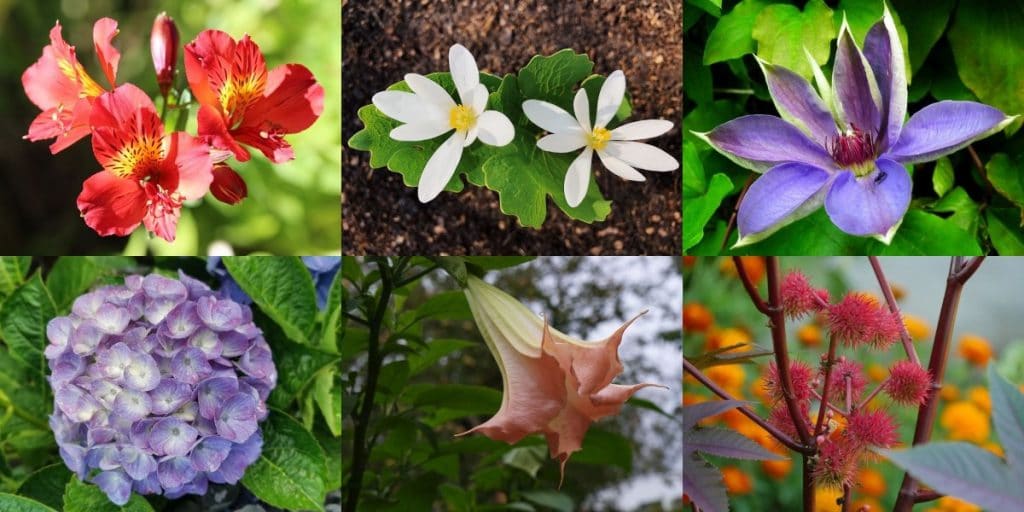Do you ever wonder why certain flowering plants are poisonous? They may look alluring and harmless, but appearances can be deceiving. Take a look at our visual guide on poisonous plants.
- Lily of the Valley
- Castor Oil Plant
- Foxglove
- Daffodil
- Tulips
- Oleander
- Desert Rose
- Angel's Trumpet (Brugmansia)
- Monkshood (Wolf’s Bane)
- Larkspur (Delphinium)
- Poinsettia
- Mountain Laurel
- Bleeding Heart
- Hydrangeas
- Calla Lily
- Baby’s Breath
- Naked Lady Lily (Amaryllis)
- Iris
- Water Hemlock
- Morning Glory
- Lantana
- Clematis
- Yarrow
- Bloodroot
- Marigold (Tagetes)
- Peace Lily (Spathiphyllum)
- Peruvian Lily
- Rhododendron
- Buttercup
- Wisteria
- What To Do If You Encounter Any of These Dangerous Plants
For poisonous plants and flowers, toxicity is a chemical form of defense mechanism against predators like herbivores. Aside from protecting themselves by forming defense structures like waxy cuticles, barks, thorns, and spikes, these living organisms are also capable of releasing toxins or highly poisonous chemical substances.
Most of these toxic plants store poisonous substances as non-toxic pre-stage components, which only turn toxic as soon as the plants get injured. Some cause immediate skin irritation upon direct contact with any parts of the plant, while others may result in even more severe life-threatening conditions or, in some cases, even death if ingested.
This article helps to identify some of the most common poisonous and potentially harmful flowering plants in gardens and homes. Also summarized are these plants’ toxic properties, as well as the possible clinical signs and effects of the toxins both in animals and humans.
Lily of the Valley
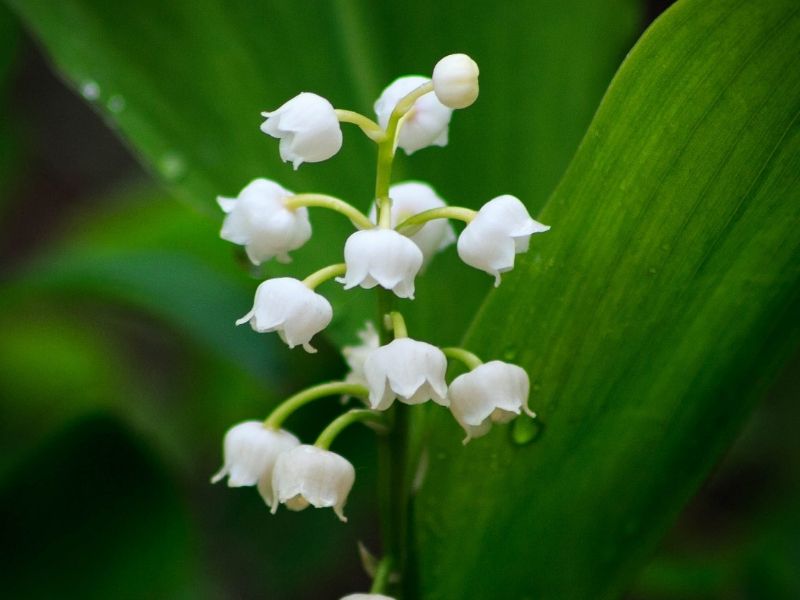
Recognized by the scientific name Convallaria majalis, the lily of the valley or sometimes written lily-of-the-valley is a highly poisonous, rhizomatous herbaceous perennial native to Europe and Central Asia.
This long-lived perennial is easy to grow as long as you provide it with moist, fertile, and well-drained soil in part or full shade. It grows up to 12 inches in height and spreads rapidly because its rhizomes tend to form dense colonies. For that reason, lily of the valley makes an ideal low-maintenance ground cover in shady areas.
These toxic plants radiate an attractive facade with their lanceolate-ovate to elliptic green foliage, an erect or arching raceme of fragrant, white, and bell-shaped flowers, and small orange-red berries.
The bell shaped flowers first appear in early to mid-spring and lasts for three weeks (1).
But how dangerous can this stunning ornamental lily be? All parts of the plant are poisonous and considered potentially toxic. The entire plant is toxic, including the flower, leaves, fruits, bark, roots, sap, seeds, and stem. They contain over 30 different types of cardiac glycosides, making the plant unsafe to grow around pets and small children.
Cardiac glycosides are organic compounds that may result in a variety of cardiac irregularities and can be fatal if ingested in large amounts. Two of the main glycosides found in lily of the valley are convallatoxin and convallamarin.
Some signs of poisoning by these toxic plants include stomach ache, vomiting, blurred vision, slow and irregular pulse, heart arrhythmia, and diarrhea (2).
Other common names of this flowering plant include may lily, lady’s tears, word lily, may bells, and more. Did you know that Lily of the Valley is May’s birth flower?
Castor Oil Plant
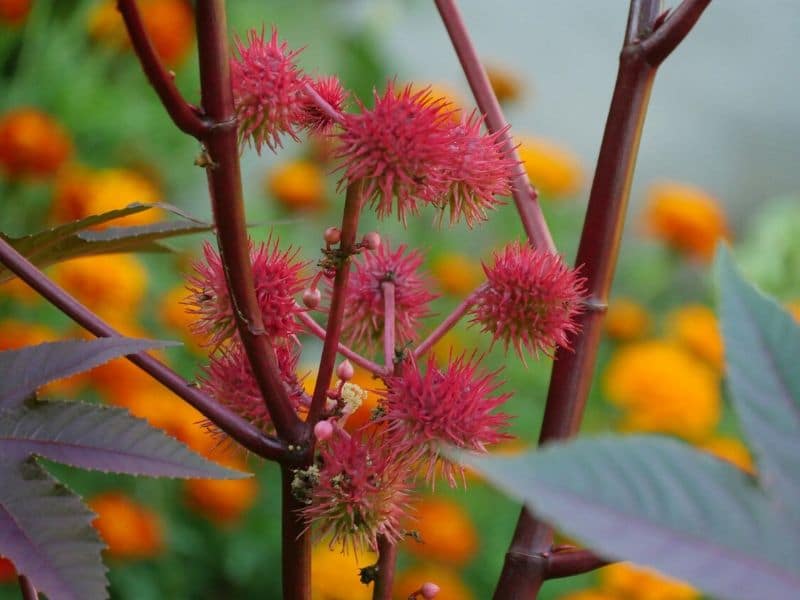
Castor oil plant or Ricinus communis comes from the Euphorbiaceae family. Often grown commercially for its oil, this flowering perennial is also popular as a landscaping ornamental and definitely one of those poisonous plants you must watch out for.
Native to India and Africa, castor oil plants are flowering shrubs that prefer warm and tropical regions. They grow about 3 meters in height with reddish-green blooms in erect spikes, spiny green or red-purple fruits, and hollow branches (3).
Most parts the plants are harmful, but the poisonous seeds are the most toxic part. Castor oil seeds or castor beans release ricin once chewed or broken. Ricin is a known poison that is highly toxic to humans and animals. Just one seed could potentially cause death. The leaves, on the other hand, may cause neuromuscular disorders when ingested in large amounts.
Signs and symptoms of castor oil plant poisoning include nausea, bloody diarrhea, vomiting, low blood pressure, an increase in heart rate, stomach pain, and seizures.
Foxglove

If you have curious young kids and pets who like spending time in your garden, one flowering plant you should steer clear of is the foxglove or common foxglove. Also known as the Digitalis spp., these fascinating herbaceous plants are unquestionably attractive but require extra caution as they produce poisonous flowers.
Renowned for ornamental and medicinal uses, the common foxglove can be harmful to humans and animals since all of its parts, particularly the leaves, flowers, and seeds, are poisonous.
When ingested, it can lead to abdominal discomfort, nausea, vomiting, diarrhea, vision issues, heart and kidney problems, and oral pain. Direct skin contact with any plant part may result in irritation of the skin.
Foxglove can either be biennial or short-lived perennial. Some of the most common foxgloves are the Digitalis purpurea and the D. lanata, which typically grow about 1.2 to 2 meters in height upon full maturity (4).
They have alternate leaves that are lanceolate to ovate in shape and green in color. The flowers, which are bell-shaped and pinkish-purple or white in color with purple blotches, form racemes. Though these purple flowers are beautiful, they are dangerous.
Daffodil

The spring favorite daffodils (Narcissus spp.) frequently cause poisoning both in individuals and pets. These beautiful flowering plants grow from bulbs, which could easily be mistaken as onion bulbs.
These bulbs contain oxalates and two alkaloids named lycorine and scillitoxin. Ingestion of daffodil bulbs may result in severe vomiting, oral irritation, diarrhea, drowsiness, and convulsions, while skin contact with the sap may cause skin and eye irritation (5).
Classified as herbaceous perennials, daffodil plants die back after flowering and regrow the following year. Mature plants reach up to 80 cm tall. They have fragrant yellow or white flowers that can be found at the end of the stems, either singly or in clusters. Each daffodil flower has six petals and a tubular-like center. The leaves are long and narrow with a basal sheath.
Tulips

Tulips or Tulipa spp. are popular perennial flowering plants with numerous species, hybrids, and cultivars. They are undeniably one of the most alluring, yet toxic plants cultivated in gardens or landscapes around the globe, considering their wide selection of breathtaking and colorful blossoms.

Like daffodils, tulip plants grow from poisonous bulbs that resemble that of an onion. Because of the similarity, tulip bulbs are unintentionally consumed mostly by animals like dogs. Some of the manifestations of tulip poisoning involve vomiting, nausea, hypersalivation, diarrhea, lethargy, and weakness.
Tulips additionally carry the allergen tulipalin, which often causes contact dermatitis following skin exposure to the plant. The tulip bulbs have the highest concentration of this allergen. The stems, leaves, and flowers contain the same allergen but in lesser concentrations (6).
Oleander
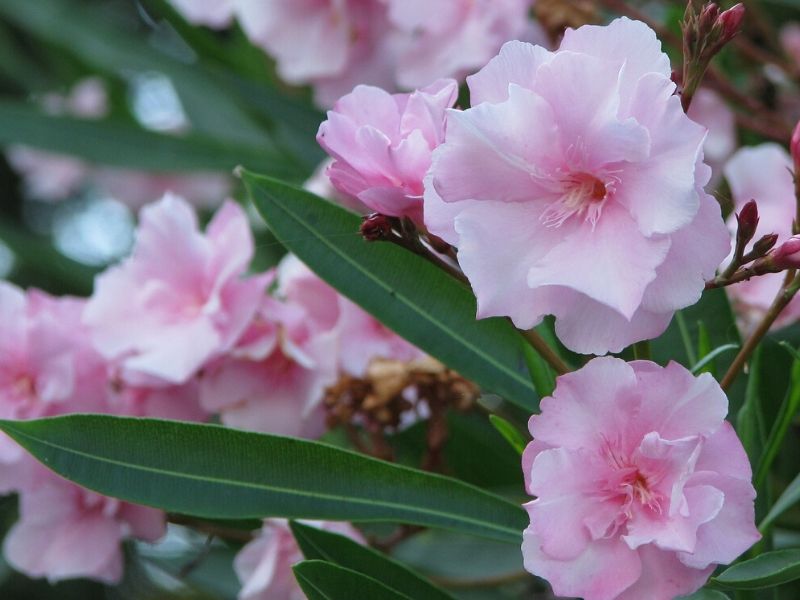
The oleander plant thrives in subtropical and tropical areas. The most common oleanders are the pink oleander (Nerium oleander) and the yellow oleander (Thevetia peruviana).
Nerium oleander and thevetia peruviana are poisonous plants. They contain several types of cardiac glycosides, including oleandrin, neriifolin, and thevetin A and B (7).
All plant parts of oleander are toxic, which, when ingested, can cause severe health conditions both in people and animals. Among the symptoms of oleander poisoning in animals like cattle, sheep, and horses are rapid breathing, mouth irritation, pupil dilation, life-threatening organ failure, and even death.
Humans that have been poisoned by this flowering plant may exhibit symptoms such as diarrhea, stomach pain, dizziness, drowsiness, mouth irritation, shortness of breath (dyspnea), bloody stools, and nausea (8).
Human death from oleander poisoning rarely occurs, even in cases of intentional ingestion (9). Nevertheless, this entire plant should be treated with caution because eating just one leaf can be life threatening.
Desert Rose
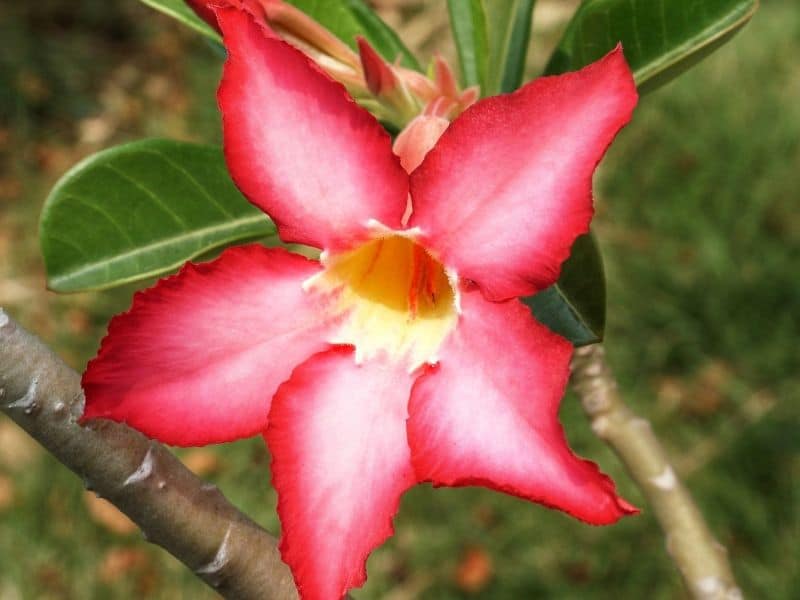
Adenium obesum, also known as the impala lily, mock azalea, Sabi star, or desert rose, is a semi-succulent shrub or small tree from the Apocynaceae family.
It grows up to 3m tall and bears five-lobed, funnel-shaped flower clusters in pink, white, or red (10). The leaves are leathery in texture and spirally arranged.
Any part of the desert rose releases sap when bruised or damage. This sap contains cardiac glycosides, which are moderately toxic, especially to animals. Ingestion of any desert rose plant part can cause gastrointestinal pain, diarrhea, vomiting, hypersalivation, and mouth and throat discomfort. Skin contact with the plant sap can cause irritation and redness.
The desert rose plant’s toxicity has its fair share of advantages, though. The sap from this plant’s roots and stems are used as arrow poison for hunting large animals and as fish toxins in Africa.
Angel’s Trumpet (Brugmansia)
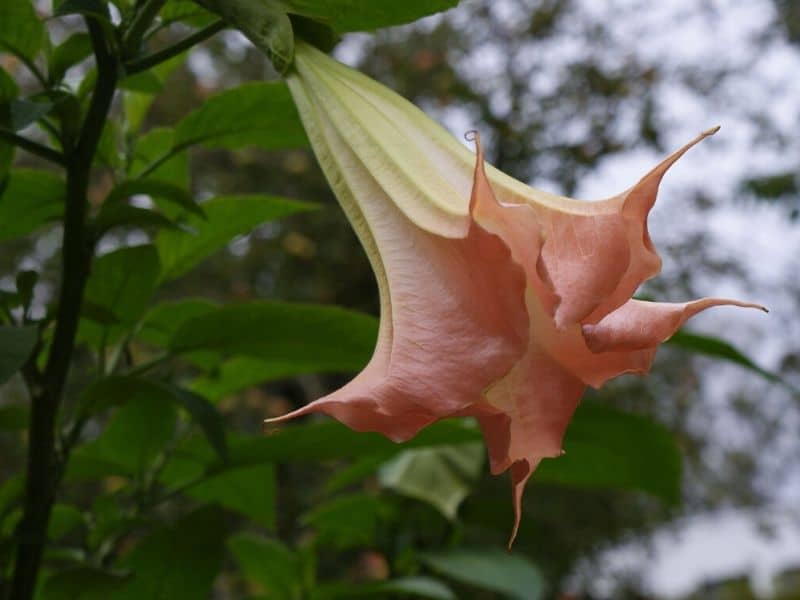
Brugmansia spp. or commonly referred to as the angel’s trumpet is a genus of small flowering trees that add fascinating details in any landscape. Putting on an attractive display of full bloom in summer and fall, angel’s trumpet plants exhibit large, trumpet-like, and fragrant flowers that are often pink, white, or yellow.
Matured angel’s trumpets grow about 8 to 14 feet high and spread up to 10 to 15 feet. Matured leaves are 6 to 8 inches long, while the flowers are usually up to 12 inches long (11).
Angel’s trumpets are highly toxic. The flowers, seeds, and leaves carry the alkaloids atropine, scopolamine, and hyoscyamine. However, poisoning only occurs if these plant parts are eaten in large quantities. Inhalation of flowers, likewise, can also be harmful.
Symptoms of angel’s trumpet poisoning include muscle weakening, hypertension, fever, dilated pupils, hallucinations, dry mouth, and paralysis (12).
Monkshood (Wolf’s Bane)

Monkshood or Aconitum napellus is a poisonous ornamental that frequents many gardens. It contains alkaloids such as aconite and aconitine. The highest concentrations of these potent toxins are in the roots and tubers.
Monkshood poisoning may occur if consumed even in small amounts or absorbed in the body through broken skin or open wounds. Effects include diarrhea, convulsions, irregular heartbeat, and even death.
However, because of their unpleasant flavor, accidental poisoning by ingestion of monkshood plants is a rare occurrence. Other common names of monkshood plants are wolf’s bane, aconite, devil’s helmet, blue rocket, and more.
Larkspur (Delphinium)
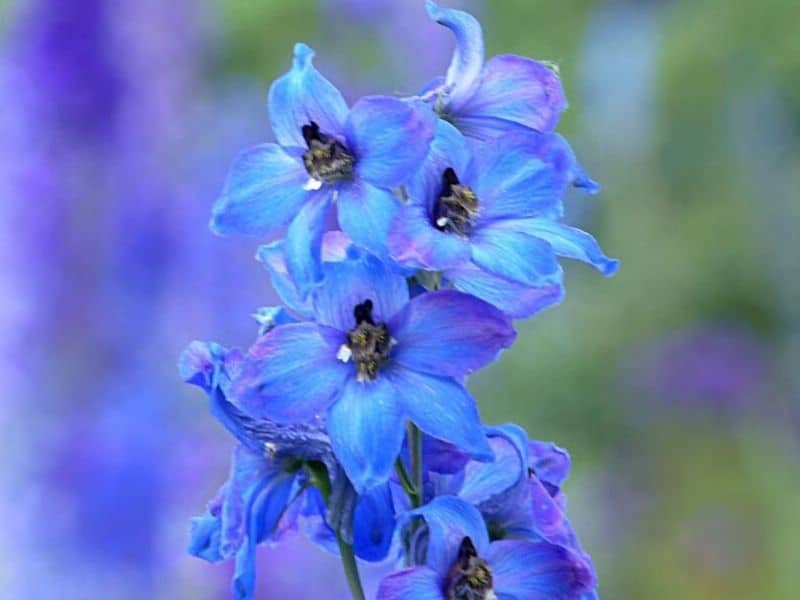
Delphinium spp., also known by its common name larkspur, often affects livestock losses, most especially cattle, due to poisoning. Consumption of any part of this flowering plant can be harmful, but the seeds and younger plant parts have the highest concentrations of toxic substances (13).
Delphinium poisoning in humans rarely happens. Affected animals experience neuro-muscular effects of the toxins. Signs of larkspur poisoning in animals include abdominal pain, constipation, diarrhea, colic, drooling, nausea and vomiting, seizure, weakness, sudden falling, labored breathing, and more.
Poinsettia
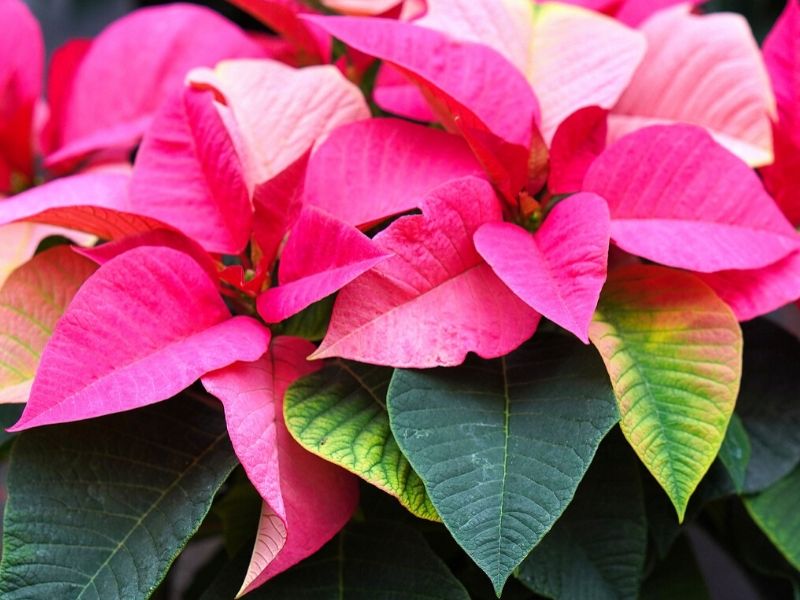
Poinsettia plant or known by its scientific name Euphorbia pulcherrima is a popular houseplant, particularly during the Christmas season. This perennial is often cultivated in pots for its bright bracts or modified leaves that resemble a flower.
Though red is the most recognized color of poinsettias, plant breeders have been producing hundreds of poinsettia varieties in different hues such as white, pink, cream, and orange.
Poinsettias are not as toxic as other recognized poisonous plants. Like most plants in the Euphorbiaceae family, it produces a milky sap. Though milky sap from other euphorbias can cause severe effects in animals and humans, the milky sap from poinsettias are reportedly less toxic (14).
Contact with the sap usually causes skin irritation, skin redness, or itchy skin in sensitive individuals, while ingestion may lead to vomiting and diarrhea.
Mountain Laurel

Mountain Laurel, also termed Kalmia latifolia, is a perennial shrub or tree from the Ericaceae family (15). It is native to North America.
Fully grown mountain laurel plants typically stand about 6.5 to 10 ft in height, though they can get as high as 40 ft. They have evergreen, glossy leaves and small dehiscent capsules (fruits). Mountain laurel flowers develop a compound corymb, usually in pink or white (16).
Aside from its ornamental significance, mountain laurel plants are also distinguished for their toxic characteristics that often affect animals like horses, sheep, cattle, and goats. All parts of the mountain laurel plants contain diterpene compounds that can cause discomfort once eaten.
Some of the symptoms of mountain laurel poisoning are excessive salivation, vomiting, abdominal pain, weakness, muscle tremors, heart irregularity, increased respiration rate, muscle tremors, and seizures (17).
Bleeding Heart

Bleeding heart or Lamprocapnos spectabilis is a herbaceous perennial that reaches about 1.5 to 4 ft in height once fully established. It is native to eastern Asia.
Recognized for its heart-shaped flowers, bleeding heart plants flourish best in moist, fertile, and well-drained soil and partial shade. The flowers are usually pink, but some cultivars exhibit varying shades. One example is the Lamprocapnos spectabilis ‘Alba’ with white blooms.
However, the beautiful blossoms of this plant come with a price. This popular garden plant requires extra caution as it can induce harm to people and pets.
All plant parts carry several isoquinoline alkaloids, which can prompt vomiting, diarrhea, convulsions, labored breathing, and tremors if ingested in high quantities. Constant contact with the sap can lead to skin irritation (18).
Hydrangeas
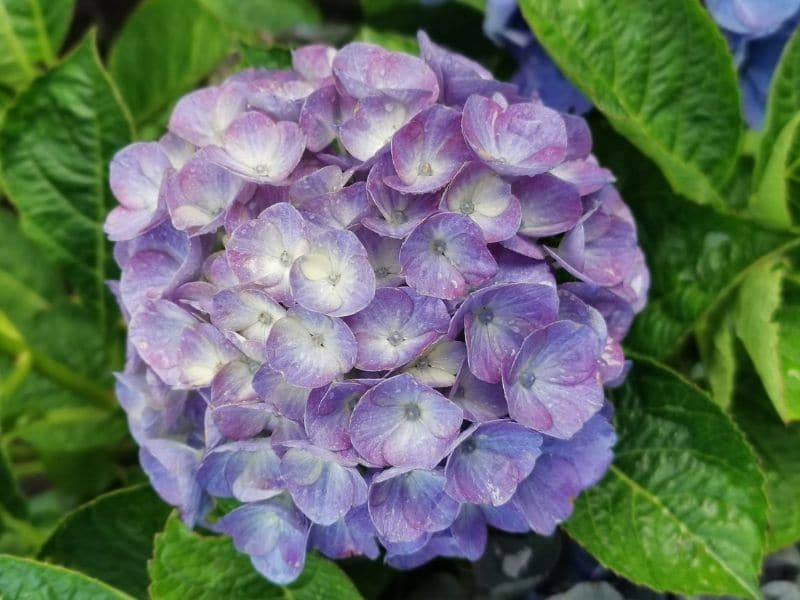
This perennial is a top favorite flowering plant by many flower aficionados for their gardens. Hydrangea is not only easy to care for but also a showstopper with its charming blooms in a wide variety of colors. The downside, however, is that this ornamental can be poisonous.
Although hydrangeas have low severity poison components, exposure to them can cause dermatitis in sensitive individuals. There are also reports on hydrangea poisoning by ingestion of the flower buds.
Hydrangeas, mainly the bark, leaves, and flowers, contain the cyanogenetic glycoside hydrangin. This toxin can result in abdominal pains, labored breathing, diarrhea, gastroenteritis, lethargy, and redness of the skin (19).
Calla Lily

Member of the Araceae family is the highly poisonous calla lily plant (Zantedeschia aethiopica). Calla lilies are herbaceous perennials characterized by prominent, arrow-shaped foliage and small flowers in a spadix, typically enclosed in a spathe.
Commonly cultivated as cut flowers or houseplants, calla lilies come in a variety of shades including yellow, white, pink, green, purple, and red. The flowering of calla lilies commences in late spring to early summer.
Calla lilies are highly toxic and can be fatal to humans and animals if ingested in massive amounts. Plant parts have calcium oxalate crystals, which can cause burning sensations, stomach pain, diarrhea, and swelling of the tongue, lips, and throat (20).
Baby’s Breath

Baby’s breath or Gypsophila spp. is frequently used as fillers in bouquets. These plants are native to Europe. Some species like the Gypsophila paniculata are perennials, while others such as the Gypsophila muralis and Gypsophila elegans are annual.
This herbaceous plant from the Carnation family has lance-shaped, gray-green to blue-green leaves and small white or pink flowers. Matured plants grow about 50 to 120 cm tall.
While baby’s breath plants are not highly toxic, they can still cause an allergic reaction in some individuals. All parts of the plant contain the saponin gyposenin, which can lead to breathing difficulties, dermatitis, and nose and sinus irritation (21).
Baby’s breath ingestion is frequent in pets. Effects include irritation to the gastrointestinal tract.
Naked Lady Lily (Amaryllis)
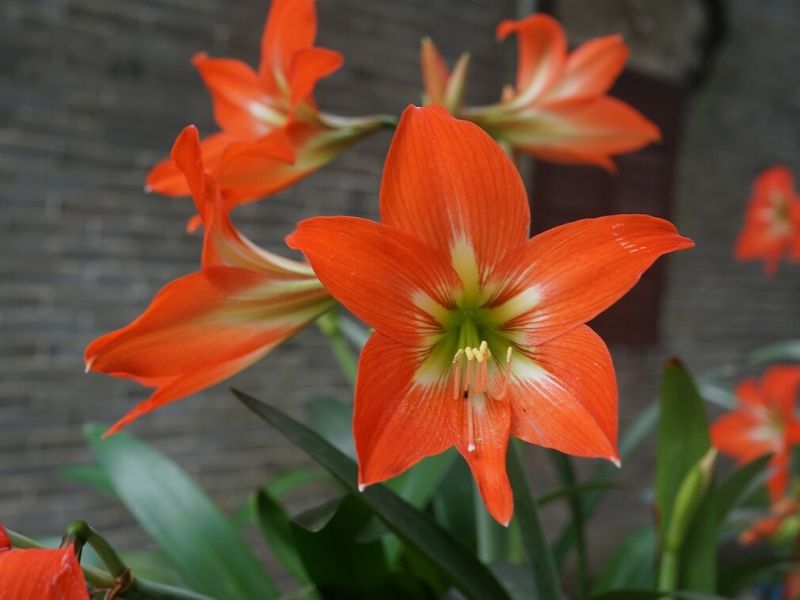
The naked lady lily plant is a famed ornamental native to South Africa. Other known names are Amaryllis belladonna (not to be confused with Atropa belladonna, the deadly nightshade), belladonna lily, march lily, or jersey lily.
Don’t be confused, though. Though it’s not a deadly nightshade, it’s still got toxic flowers to watch out for.
This plant is a bulbous perennial characterized by fragrant, funnel-shaped, brightly-colored blossoms, and “naked” or leafless stems (22).
The Amaryllis plant contains lycorine and other toxic components that could harm humans and animals. Poisoning from the naked lady lily plant often leads to vomiting, depression, diarrhea, tremors, hypersalivation, and abdominal pain.
Iris

Widely cultivated as an ornamental plant, iris (Iris spp.) comes from the Iridaceae family. With many species and cultivars, the iris genus has countless of floral types and colors, and varying bloom periods. These perennials develop from bulbs or rhizomes.
They feature upright green to blue-green foliage, complex flowers with three “standards” (upright inner petals) and three “falls” (drooping outer petals), and brown capsule fruits (23).
Although iris plants contain toxic compounds such as irisin, iridin, and irisine, the severity of poison is generally considered low. Some of the clinical signs of iris poisoning include vomiting, nausea, diarrhea, abdominal pain, and skin irritation.
Water Hemlock

Cicuta spp. or also called water hemlock is a dangerous perennial plant from the carrot family that grows about 2 to 7 ft high. One of its key features is the umbel clusters of small white flowers on long stalks that bloom in spring or early summer. The flowers of this species are similar to those of its relative, the poison hemlock.
The Queen Anne’s lace plant, also from the carrot family, is widely consumed when the root is young. Unfortunately, the similarity between it and the hemlock species has caused many deaths in the past.
The stem and leaves of poison hemlock are highly poisonous because of the presence of cicutoxin, a toxic chemical compound. Cicutoxin induces seizures, gastrointestinal discomfort, sweating, hypersalivation, convulsions, hypoxia, and more (24).
The onset of water hemlock poisoning following the consumption of toxic plant parts can be within 15 minutes.
Morning Glory
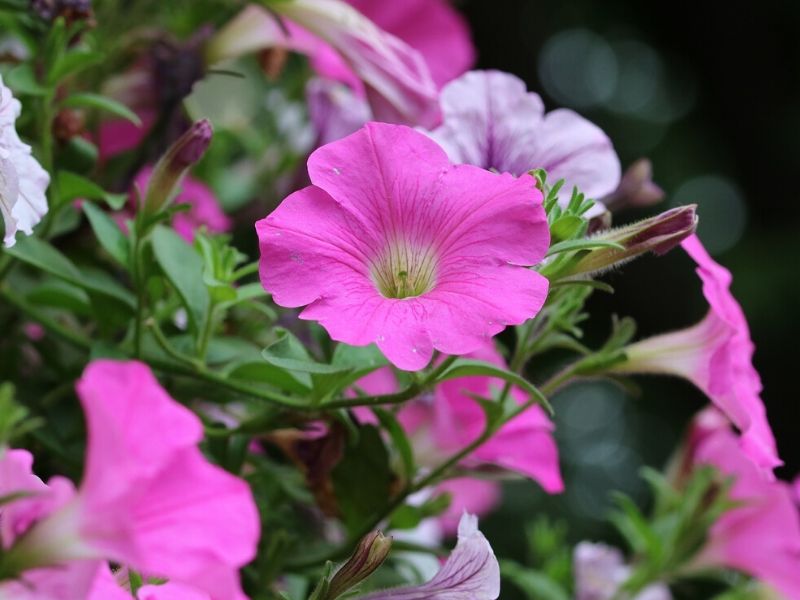
Morning glory (Ipomea spp.) is a flowering plant species in the Convolvulaceae family. These climbers have heart-shaped leaves and trumpet-shaped flowers in white, blue, magenta, or purple. Flowering commences in early summer.
Some of the most remarkable varieties of morning glory include “Heavenly Blue” (blue flowers with a white throat), “Scarlett O’Hara” (wine-red flowers with a white throat), and “Kniola’s Black Knight” (deep purple flowers with a pink throat).
Keep the morning glory plants out of reach of kids and pets since they can be harmful. Morning glory seeds present toxic lysergic alkaloids that are similar to LSD. Ingestion in large amounts can result in diarrhea, liver failure, or hallucinations.
Lantana

Lantana (Lantana camara) is a flowering plant with a tendency to become a weed because of its invasive growth characteristics. It is usually a dense shrub that grows 2 to 4 m in height.
This ornamental shrub exhibits dense clusters of small and colorful flowers that quickly add value in any garden. The colors of the blooms differ and vary from yellow to orange, white, cream, red, pink, or multi-colored (25).
Lantana flowers attract butterflies and bees with their fragrance, but beyond all that is a potential danger that could do more harm than good to humans and animals.
A recognized poisonous plant, lantana produces a toxin that mildly or severely affects individuals and animals, particularly livestock. Effects in humans include vomiting, diarrhea, breathing problems, weak muscles, and death.
Poisoning frequently happens in animals. Early symptoms are appetite loss, depression, frequent urination, jaundice, constipation, inflamed eyes and mouth, and liver and kidney failure (26).
Clematis
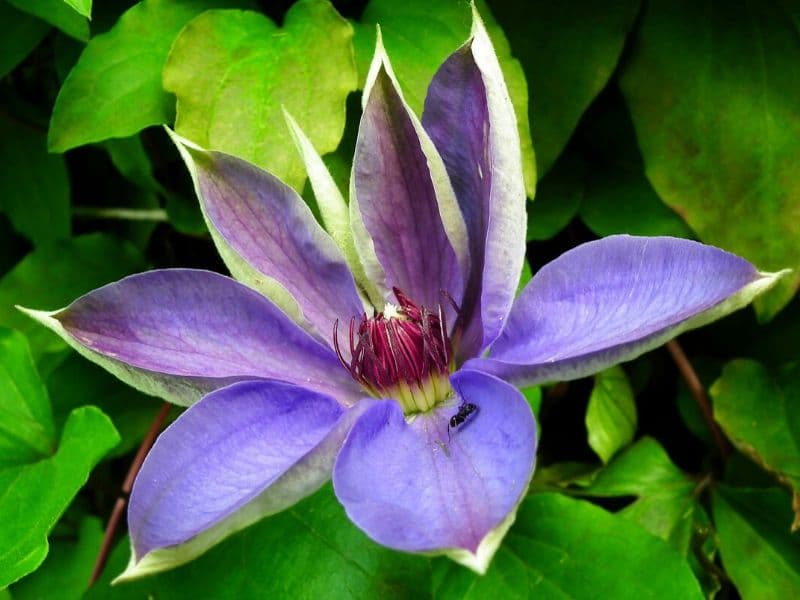
Popular among gardeners and flower enthusiasts is the clematis plant or commonly known as the leather flower. It belongs in the Ranunculaceae or buttercup family.
This perennial and deciduous vine delivers plentiful blooms in vivid colors that instantly turn head anywhere. However, beyond the promising beauty of this plant is a potential harm to humans and animals.
Clematis vines have harmful components like the irritant glycoside ranunculin. Consumption of these dangerous plants may cause hypersalivation, mouth irritation, and diarrhea, but effects are short-term and typically subside immediately (27).
Yarrow
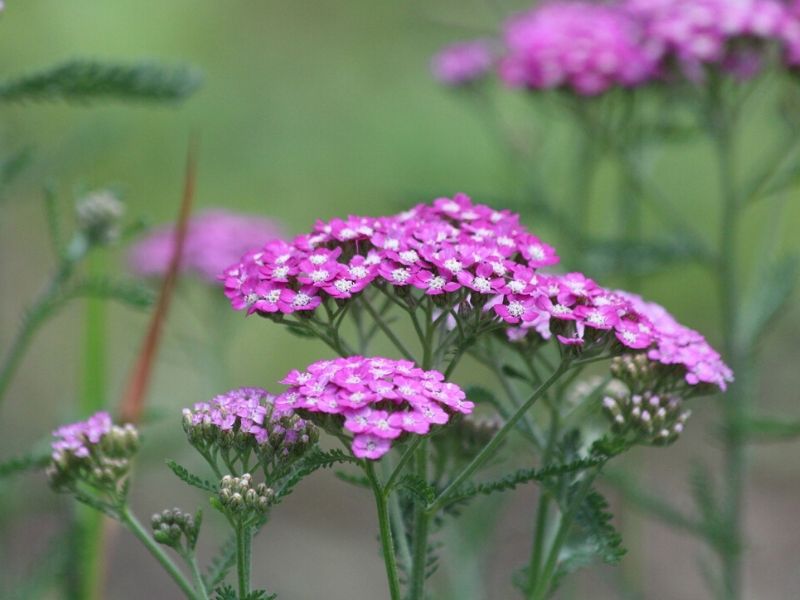
Valued for their medicinal properties and ornamental uses, yarrows from the Asteraceae family can also be toxic to humans and animals if misused. This plant is widely consumed despite the risk of poisoning.
Also named as Achillea millefolium, yarrows are fast-growing perennial plants native to Europe. They have fern-like feathery foliage and clusters of small and white flowers. Mature plants usually reach 1 to 3 ft in height (28).
Several cases of livestock poisoning due to yarrows have been reported in the past. The plant contains toxic chemicals that can induce allergic reactions like eczema, rashes, and dermatitis.
Bloodroot
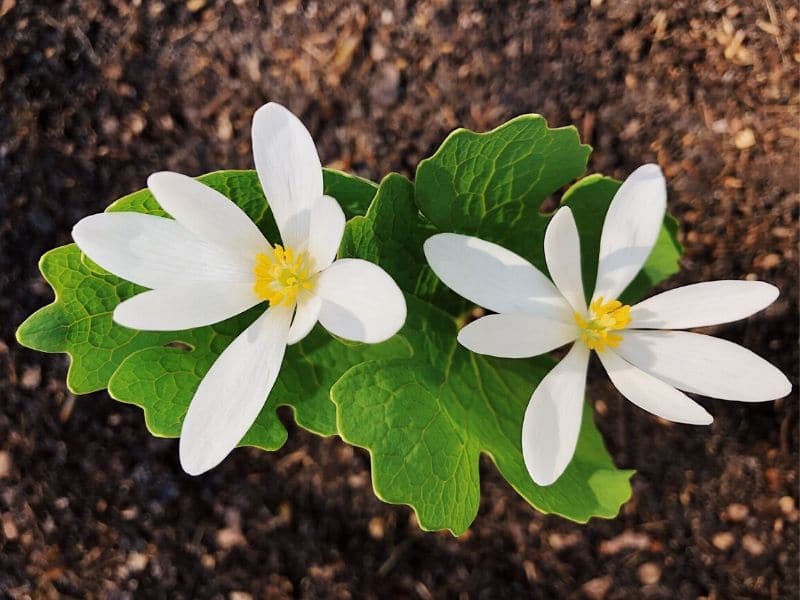
Bloodroot or Sanguinaria canadensis is a herbaceous flowering plant native to the eastern part of North America. It blooms early in spring and displays delicate white flowers and large rounded leaves.
Bloodroot plants are perennials. Aside from being highly accepted for their medicinal properties and other uses, these common plants have toxic properties that can be detrimental to both humans and animals.
The name bloodroot is a reference to the red latex produced by this plant’s rhizomes. This latex contains several alkaloids like sanguinarine, that when ingested in large amounts, are poisonous (29).
Even direct contact with the sap can cause skin irritation (30). Some of the clinical signs of bloodroot poisoning are nausea, vomiting, diarrhea, heart failure, faintness, dizziness, and dilated pupils (31).
Marigold (Tagetes)
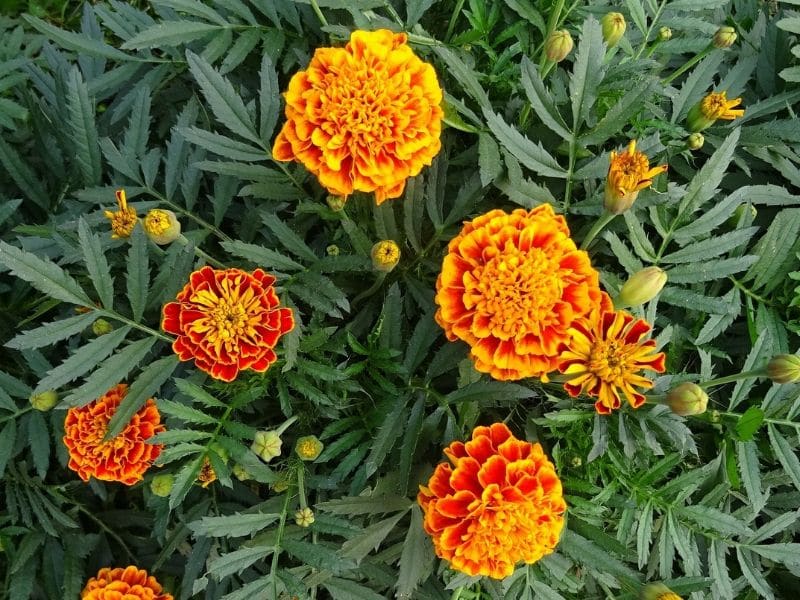
Marigold (Tagetes spp.) is a long-blooming flowering genus in the Asteraceae family. These herbaceous annuals can be found typically in flower gardens or pots or containers as houseplants. Flower blooms in fall and summer, with colors varying from golden yellow to orange, red, or burgundy.
The flowers are edible but can be toxic if consumed excessively. The leaves and roots have toxic potential as well and can cause contact dermatitis, blisters, and nose and eye irritation (32).
Peace Lily (Spathiphyllum)

Peace lilies, also known as Madonna lily or Spathiphyllum spp. are not true lilies. Part of the Araceae or Arum family, they display a spadix often enclosed in a white to greenish-white spathe type of inflorescence. The basal rosettes of leaves are glossy, dark green, and oblong-lanceolate in shape.
Peace lilies are perennials native to tropical America. Although not as poisonous as other dangerous plants in this list, the leaves of peace lilies contain calcium oxalate crystals that can cause the burning of lips, tongue, and throat if eaten in large quantities (33).
Peruvian Lily
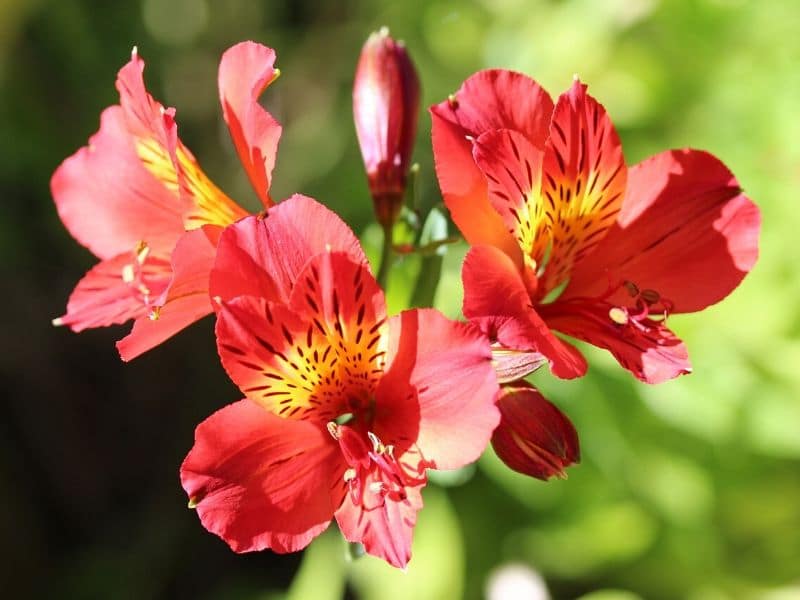
Otherwise referred to as the lily of the Incas or Alstroemeria spp., Peruvian lilies are vibrant and long-lasting flowering plants in the Alstroemeriaceae family. They are herbaceous perennials that thrive best in full sun and well-drained soil.
The funnel-shaped flowers bloom in spring and summer with colors ranging from orange to pink, salmon, rose, white, yellow, red, and purple. The leaves are green, lanceolate-linear, and arranged alternately on an erect stem.
Planting Peruvian lilies as houseplants require extra caution since they are highly poisonous. They contain potent glycosides, which can cause contact dermatitis and poisoning to humans and animals.
Symptoms of Peruvian lily poisoning include severe skin irritation, eye irritation, and blisters (34). If eaten, the plant can cause vomiting, nausea, and diarrhea (35).
Rhododendron
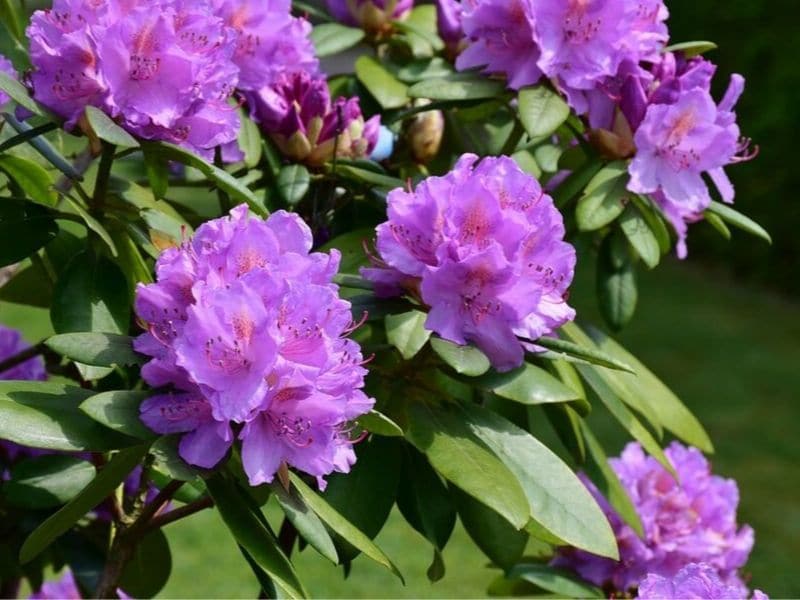
With a display of vibrant and attractive blooms, rhododendrons are highly-valued ornamental plants. They are popular garden shrubs that thrive best in acidic soil with a pH between 5.0 to 5.5, excellent drainage, and partial shade. Some species of rhododendrons are evergreen, while others are deciduous (36).
These common plants contain grayanotoxin, a toxic compound that can poison animals and people. Clinical effects usually commence within a few hours after the ingestion of any plant part. These include vomiting, diarrhea, colic, loss of appetite, weakness, loss of coordination, leg paralysis, weak heart rate, and excessive salivation (37). Interestingly, the honey made from rhododendron flowers is also toxic. Ingestion of this honey, also called mad honey, is known to cause low blood pressure and a lower heart rate which can even be life-threatening.
Buttercup
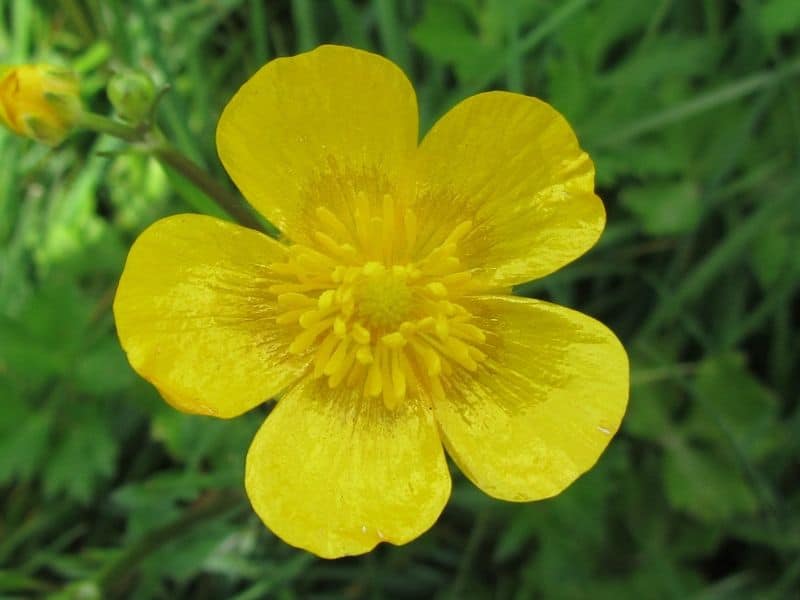
Buttercup’s vivid yellow flowers sure brighten any area in your garden. Coming from the Ranunculus genus, these herbaceous flowering plants are widely distributed across the globe and sometimes considered as weeds because of their invasive and prolific nature.
Buttercup may have alluring blooms, but they are highly toxic to animals and humans. The plants contain the glycoside ranunculin. They can cause diarrhea, hypersalivation, and reddening of the oral mucous membranes once any plant part is ingested (38).
Wisteria
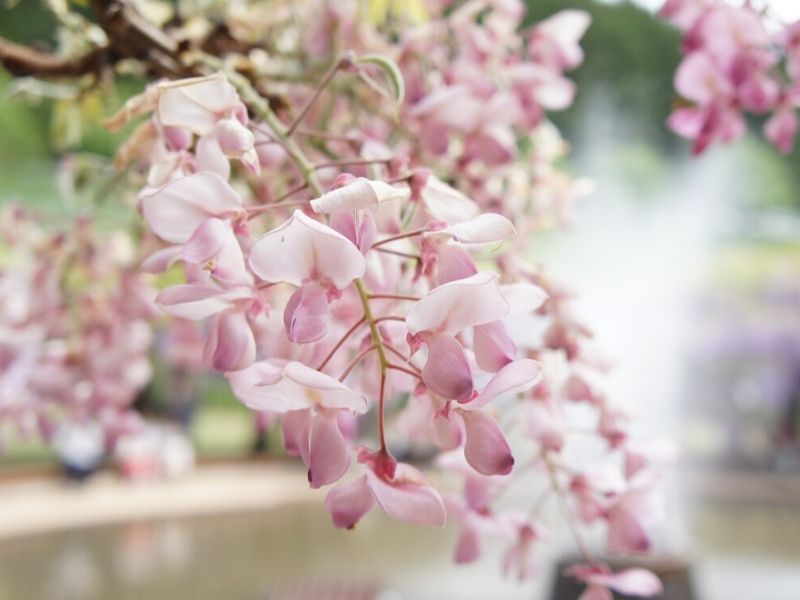
Part of the legume family is a floriferous ornamental vine named wisteria (Wisteria spp.). It is well-liked for its stunning, long drooping clusters of purple to pink or white flowers. The compound leaves are alternate, with ovate to elliptic leaflets (39). Some wisteria varieties originated in Japan and China, while others are from America.
Marked as a poisonous ornamental, wisteria contains the glycoside wisterin and a toxin resin in all plant parts. Hungry pets often ingest this plant, particularly the seeds, and experience poisoning symptoms as a result. Nausea, vomiting, stomach pain, and diarrhea are a few of the typical effects of wisteria poisoning in pets. This is why you need to be extra careful when growing wisteria as a bonsai (40).
So there you have it, make sure to keep an eye on these deadly flowers when planting around your house, especially when you have children and pets, and call poison control right away if you suspect accidental ingestion. These aren’t the only poisonous plants out there either.
There are others like poison oak, rosary pea, and deadly nightshade berries as well. A small fact before we go, rosary peas are often used in prayer rosaries. Also, don’t forget common plants like nettles that can cause skin irritations with their formic acid covered fibers.
What To Do If You Encounter Any of These Dangerous Plants
Identifying poisonous plants is the first step in staying safe. Now that you have the guide above, you’re on the right track!
In general, know that some dangerous plants have toxic leaves, while others are more dangerous when you come into contact with the seeds or sap. The poison ricin, for example, comes from the seeds of the castor oil plant, which is found in many parts of the world.
These dangerous plants can cause a severe allergic reaction, symptoms of which include high blood pressure, difficulty breathing, and severe dehydration. If you think you have come into contact with a toxic plant, the first thing to do is to clean the affected area immediately. Use soap and water, and don’t touch your face or eyes.
If you start to experience severe symptoms, you need to seek medical attention immediately. Symptoms of plant poisoning can include heart failure, respiratory paralysis, an irregular heartbeat, and a burning sensation on the skin.
If you experience any of these symptoms, you need to call emergency services or get to a hospital as soon as possible. Time is of the essence when dealing with exposure to dangerous plant substances.
Home remedies can be useful for treating mild symptoms, but you should never try to self-diagnose your symptoms or rely on home remedies for severe cases.
Some people advocate for the use of activated charcoal or milk of magnesia to help absorb plant toxins and cause vomiting, but these remedies are not proven to be very effective. If you are experiencing severe symptoms, do not waste time trying home remedies. Instead, see a medical professional immediately.
Removing a Poisonous Plant From Your Garden
If you need to remove a poisonous plant, like poison ivy, poison hemlock, poison oak, or poison sumac from your yard or garden, it’s essential to wear gloves and protective clothing to avoid exposure to any parts of the plant.
You should also wash your clothing and any tools you use to remove the poison ivy plants to avoid spreading the toxic oils.
If you do get exposed to these dangerous plants, you can try using a topical cream or lotion to help soothe the skin and reduce itching. However, if you experience severe symptoms, such as pain, swelling, or infection, you need to see a doctor right away.
Enjoy this list? Save for later reference!
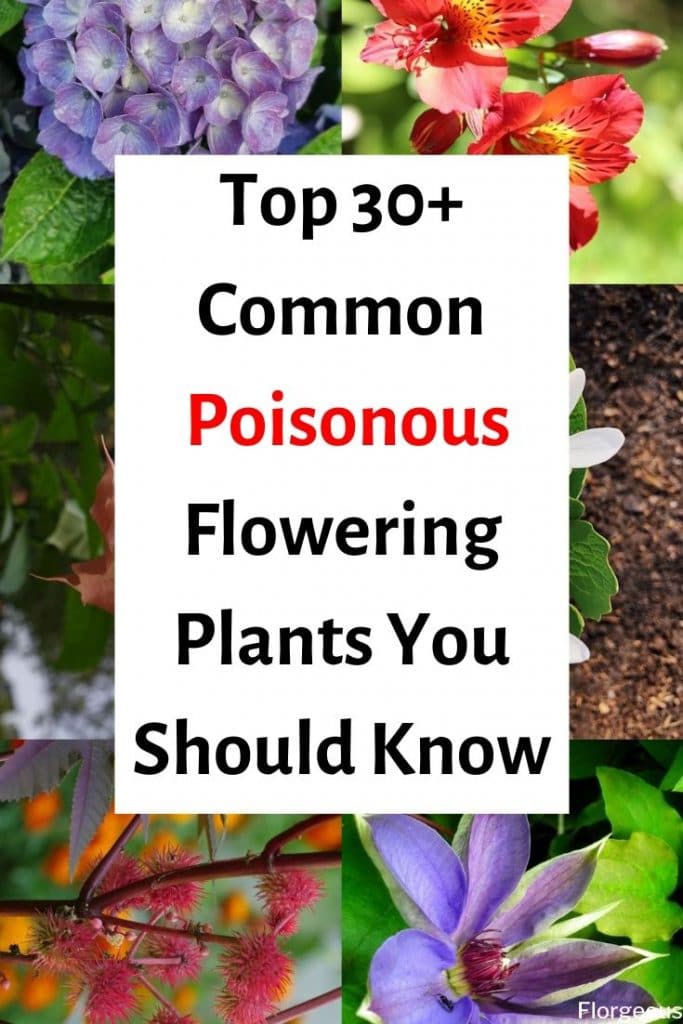
Up Next: 300+ Flower Names and Types with Pictures
References
Reference List
(1) Missouri Botanical Garden (2019). Convallaria majalis – Plant Finder. [online] Available at https://www.missouribotanicalgarden.org/
(2) Plants.ces.ncsu.edu. (2019). Convallaria majalis (Lily of the Valley, Lily-of-the-valley) | North Carolina Extension Gardener Plant Toolbox. [online] Available at: https://plants.ces.ncsu.edu/plants/convallaria-majalis/
(3) Daf.qld.gov.au. (2019). [online] Available at: https://www.daf.qld.gov.au/__data/assets/pdf_file/0010/59797/IPA-Castor-Oil-Bush-PP44.pdf
(4) Hort.purdue.edu. (2019). FOXGLOVE. [online] Available at: https://hort.purdue.edu/newcrop/med-aro/factsheets/FOXGLOVE.html
(5) Children’s Health Queensland. (2017). Daffodil (Narcissus) | Queensland Poisons Information Centre. [online] Available at: https://www.childrens.health.qld.gov.au/poisonous-plant-daffodil-narcissus/
(6) Cbif.gc.ca. (2014). Canadian Poisonous Plants Information System – Tulip (Common name) – Canadian Biodiversity Information Facility (CBIF). [online] Available at: https://www.cbif.gc.ca/eng/species-bank/canadian-poisonous-plants-information-system/all-plants-common-name/tulip/?id=1370403267228
(7) Bandara, V., Weinstein, S., White, J. and Eddleston, M. (2010). A review of the natural history, toxinology, diagnosis and clinical management of Nerium oleander (common oleander) and Thevetia peruviana (yellow oleander) poisoning. Toxicon, 56(3), pp.273-281. link
(8) Cbif.gc.ca. (2013). Canadian Poisonous Plants Information System – Nerium oleander (Scientific name) – Canadian Biodiversity Information Facility (CBIF). [online] Available at: https://www.cbif.gc.ca/eng/species-bank/canadian-poisonous-plants-information-system/all-plants-scientific-name/nerium-oleander/?id=1370403266943
(9) Langford, S. and Boor, P. (1996). Oleander toxicity: an examination of human and animal toxic exposures. Toxicology, 109(1), pp.1-13. – link
(10) Children’s Health Queensland. (2017). Desert rose (Adenium obesum) | Queensland Poisons Information Centre. [online] Available at: https://www.childrens.health.qld.gov.au/poisonous-plant-desert-rose-adenium-obesum/
(11) Hort.ufl.edu. (2019). [online] Available at: http://hort.ufl.edu/database/documents/pdf/shrub_fact_sheets/brusppa.pdf
(12) Plants.ces.ncsu.edu. (2019). Brugmansia (Angel’s Trumpet, Floripondios, Moonflowers, Tree Daturas) | North Carolina Extension Gardener Plant Toolbox. [online] Available at: https://plants.ces.ncsu.edu/plants/brugmansia-datura/
(13) Ars.usda.gov. (2019). Larkspur (Delphinium spp.) : USDA ARS. [online] Available at: https://www.ars.usda.gov/pacific-west-area/logan-ut/poisonous-plant-research/docs/larkspur-delphinium-spp/
(14) Gwaltney-Brant, S. (2013). Christmastime Plants. Small Animal Toxicology, pp.499-511.
(15) Plants.usda.gov. (2019). Plants Profile for Kalmia latifolia (mountain laurel). [online] Available at: https://plants.usda.gov/core/profile?symbol=KALA
(16) Hort.uconn.edu. (2019). Plant Database. [online] Available at: http://www.hort.uconn.edu/plants/detail.php?pid=236
(17) Csuvth.colostate.edu. (2019). Guide to Poisonous Plants – College of Veterinary Medicine and Biomedical Sciences – Colorado State University. [online] Available at: https://csuvth.colostate.edu/poisonous_plants/Plants/Details/112
(18) Plants.ces.ncsu.edu. (2019). Lamprocapnos spectabilis (Bleeding Heart, Japanese Bleeding Heart) | North Carolina Extension Gardener Plant Toolbox. [online] Available at: https://plants.ces.ncsu.edu/plants/lamprocapnos-spectabilis/
(19) Cbif.gc.ca. (2013). Canadian Poisonous Plants Information System – Hydrangea (Common name) – Canadian Biodiversity Information Facility (CBIF). [online] Available at: https://www.cbif.gc.ca/eng/species-bank/canadian-poisonous-plants-information-system/all-plants-common-name/hydrangea/?id=1370403267136
(20) Plants.ces.ncsu.edu. (2019). Zantedeschia (Calla Lily) | North Carolina Extension Gardener Plant Toolbox. [online] Available at: https://plants.ces.ncsu.edu/plants/zantedeschia
(21) Plants.ces.ncsu.edu. (2019). Gypsophila paniculata (Baby’s Breath) | North Carolina Extension Gardener Plant Toolbox. [online] Available at: https://plants.ces.ncsu.edu/plants/gypsophila-paniculata
(22) Bostan, Nadia & Sajid, Muhammad & Wahid, Fazal & Rabi, Fazal & Qureshi, Sufyan & Ahmad, Waqas & Ahmad, Shawana & Tawab, Saleha. (2014). Effects of Growing Media and Irrigation Interval on Growth of Amaryllis (Amaryllis Belladonna). Advances in Life Science and Technology. 18. 20-27.
(23) Plantfacts.osu.edu. (2019). [online] Available at: https://plantfacts.osu.edu/pdf/0246-597xx.pdf
(24) Magill, A.J. & Ryan, E.T. & Solomon, T. & Hill, D.R.. (2012). Hunter’s Tropical Medicine and Emerging Infectious Disease: Ninth Edition.
(25) Weeds.brisbane.qld.gov.au. (2019). lantana | Weed Identification – Brisbane City Council. [online] Available at: https://weeds.brisbane.qld.gov.au/weeds/lantana
(26) Weeds.dpi.nsw.gov.au. (2019). NSW WeedWise. [online] Available at: https://weeds.dpi.nsw.gov.au/Weeds/Lantana
(27) Csuvth.colostate.edu. (2019). Guide to Poisonous Plants – College of Veterinary Medicine and Biomedical Sciences – Colorado State University. [online] Available at: https://csuvth.colostate.edu/poisonous_plants/Plants/Details/136
(28) Aggie-horticulture.tamu.edu. (2019). Yarrow. [online] Available at: https://aggie-horticulture.tamu.edu/wildseed/42/42.5.html
(29) Croaker, A., King, G., Pyne, J., Anoopkumar-Dukie, S. and Liu, L. (2016). Sanguinaria canadensis: Traditional Medicine, Phytochemical Composition, Biological Activities and Current Uses. International Journal of Molecular Sciences, 17(9), p.1414.
(30) Nps.gov. (2019). Bloodroot – Shenandoah National Park (U.S. National Park Service). [online] Available at: https://www.nps.gov/shen/learn/nature/wf_bloodroot.htm
(31) Plants.ces.ncsu.edu. (2019). Sanguinaria canadensis (Bloodroot) | North Carolina Extension Gardener Plant Toolbox. [online] Available at: https://plants.ces.ncsu.edu/plants/sanguinaria-canadensis/
(32) Plants.ces.ncsu.edu. (2019). Tagetes (Marigold) | North Carolina Extension Gardener Plant Toolbox. [online] Available at: https://plants.ces.ncsu.edu/plants/tagetes
(33) Plants.ces.ncsu.edu. (2019). Spathiphyllum (Peace Lily, Spathe Flower, White Sails) | North Carolina Extension Gardener Plant Toolbox. [online] Available at: https://plants.ces.ncsu.edu/plants/spathiphyllum
(34) Plants.ces.ncsu.edu. (2019). Alstroemeria (Lily-of-the-Incas, Peruvian Lily) | North Carolina Extension Gardener Plant Toolbox. [online] Available at: https://plants.ces.ncsu.edu/plants/alstroemeria/#poison
(35) Children’s Health Queensland. (2017). Peruvian lily (Alstroemeria) | Queensland Poisons Information Centre. [online] Available at: https://www.childrens.health.qld.gov.au/poisonous-plant-peruvian-lily-alstroemeria/
(36) Extension2.missouri.edu. (2019). [online] Available at: https://extension2.missouri.edu/g6825
(37) Csuvth.colostate.edu. (2019). Guide to Poisonous Plants – College of Veterinary Medicine and Biomedical Sciences – Colorado State University. [online] Available at: https://csuvth.colostate.edu/poisonous_plants/Plants/Details/111
(38) Csuvth.colostate.edu. (2019). Guide to Poisonous Plants – College of Veterinary Medicine and Biomedical Sciences – Colorado State University. [online] Available at: https://csuvth.colostate.edu/poisonous_plants/Plants/Details/88
(39) Children’s Health Queensland. (2017). Wisteria (Wisteria floribunda) | Queensland Poisons Information Centre. [online] Available at: https://www.childrens.health.qld.gov.au/poisonous-plant-wisteria-floribunda/
(40) Plants.ces.ncsu.edu. (2019). Wisteria (Wisteria) | North Carolina Extension Gardener Plant Toolbox. [online] Available at: https://plants.ces.ncsu.edu/plants/wisteria/
Close

